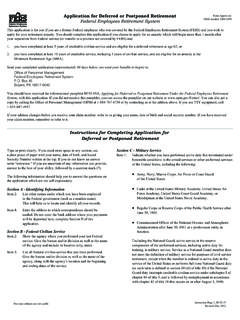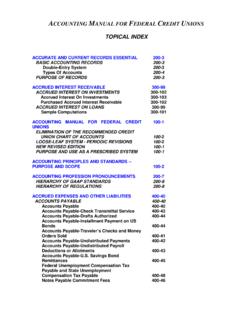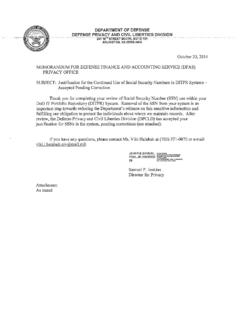Transcription of Regulation D
1 Regulation D. reserve Requirements of Depository Institutions 12 CFR 204; as amended effective July 30, 1998. Table of Contents with federal reserve Regulatory Service location numbers Regulation D - - - - - - - - - - - - - - - - - - - - - - - - - - -(FRRS #s 2-122 thru 2-207). Statutory Authority for Regulation D - - - - - - - - - - - - -(FRRS #s 2-209 thru 2-243). Board Interpretations of Regulation D - - - - - - - - - - - -(FRRS #s 2-259 thru 2-287). Questions and Answers About Regulation D - - - - - - - -(FRRS #s 2-300 thru ). Board Rulings and Staff Opinions Interpreting Reg. D - - -(FRRS #s 2-310 thru ). Section Authority, purpose and scope Definitions Computation and maintenance Transitional adjustments in mergers Emergency reserve requirement Supplemental reserve requirement Penalties International banking facilities Supplement: reserve requirement ratios SECTION , Purpose and Scope (2-122) Regulation D: SECTION -- Authority, Purpose and Scope 2-122. SECTION , Purpose and Scope (a) Authority.
2 This part * is issued under the authority of section 19 (12 USC 461 et seq.). and other provisions of the federal reserve Act and of section 7 of the International Banking Act of 1978 (12 USC 3105). (b) Purpose. This part relates to reserves that depository institutions are required to maintain for the purpose of facilitating the implementation of monetary policy by the federal reserve System. (2-123) Regulation D: SECTION -- Authority, Purpose and Scope 2-123. (c) Scope. (1) The following depository institutions are required to maintain reserves in accordance with this part: (i) Any insured bank as defined in section 3 of the federal Deposit Insurance Act (12. USC 1813(h)) or any bank that is eligible to apply to become an insured bank under section 5 of such act (12 USC 1815);. (ii) Any savings bank or mutual savings bank as defined in section 3 of the federal Deposit Insurance Act (12 USC 1813(f), (g));. (iii) Any insured credit union as defined in section 101 of the federal Credit Union Act (12 USC 1752(7)) or any credit union that is eligible to apply to become an insured credit union under section 201 of such act (12 USC 1781).
3 (iv) Any member as defined in section 2 of the federal Home Loan Bank Act (12 USC. 1422(4)); and (v) Any insured institution as defined in section 401 of the National Housing Act (12. USC 1724(a)) or any institution which is eligible to apply to become an insured institution under section 403 of such act (12 USC 1726). (2-124) Regulation D: SECTION -- Authority, Purpose and Scope 2-124. (2) Except as may be otherwise provided by the Board, a foreign bank's branch or agency located in the United States is required to comply with the provisions of this part in the same manner and to the same extent as if the branch or agency were a member bank, if its parent foreign bank (i) has total worldwide consolidated bank assets in excess of $1. billion; or (ii) is controlled by a foreign company or by a group of foreign companies that own or control foreign banks that in the aggregate have total worldwide consolidated bank assets in excess of $1 billion. In addition, any other foreign bank's branch located in the United States that is eligible to apply to become an insured bank under section 5 of the federal Deposit Insurance Act (12 USC 1815) is required to maintain reserves in accordance with this part as a nonmember depository institution.
4 (2-125) Regulation D: SECTION -- Authority, Purpose and Scope 2-125. (3) Except as may be otherwise provided by the Board, an Edge corporation (12 USC 611. et seq.) or an agreement corporation (12 USC 601 et seq.) is required to comply with the provisions of this part in the same manner and to the same extent as a member bank. (4) This part does not apply to any financial institution that (i) is organized solely to do business with other financial institutions; (ii) is owned primarily by the financial institutions with which it does business; and (iii) does not do business with the general public. (5) The provisions of this part do not apply to any deposit that is payable only at an office located outside the United States. 2-126. SECTION For purposes of this part, the following definitions apply unless otherwise specified: (a)(1) "Deposit" means-- (i) the unpaid balance of money or its equivalent received or held by a depository institution in the usual course of business and for which it has given or is obligated to give credit, either conditionally or unconditionally, to an account, including interest credited, or which is evidenced by an instrument on which the depository institution is primarily liable.
5 (ii) money received or held by a depository institution, or the credit given for money or its equivalent received or held by the depository institution in the usual course of business for a special or specific purpose, regardless of the legal relationships established thereby, including escrow funds, funds held as security for securities loaned by the depository institution, funds deposited as advance payment on subscriptions to United States government securities, and funds held to meet its acceptances;. (iii) an outstanding teller's check, or an outstanding draft, certified check, cashier's check, money order, or officer's check drawn on the depository institution, issued in the usual course of business for any purpose, including payment for services, dividends, or purchases;. (2-127) Regulation D: SECTION -- Definitions 2-127. (iv) any due bill or other liability or undertaking on the part of a depository institution to sell or deliver securities to, or purchase securities for the account of, any customer (including another depository institution), involving either the receipt of funds by the depository institution, regardless of the use of the proceeds, or a debit to an account of the customer before the securities are delivered.
6 A deposit arises thereafter, if after three business days from the date of issuance of the obligation, the depository institution does not deliver the securities purchased or does not fully collateralize its obligation with securities similar to the securities purchased. A security is similar if it is of the same type and if it is of comparable maturity to that purchased by the customer;. (2-128) Regulation D: SECTION -- Definitions 2-128. (v) any liability of a depository institution's affiliate that is not a depository institution, on any promissory note, acknowledgment of advance, due bill, or similar obligation (written or oral), with a maturity of less than one and one-half years, to the extent that the proceeds are used to supply or to maintain the availability of funds (other than capital) to the depository institution, except any such obligation that, had it been issued directly by the depository institution, would not constitute a deposit. If an obligation of an affiliate of a depository institution is regarded as a deposit and is used to purchase assets from the depository institution, the maturity of the deposit is determined by the shorter of the maturity of the obligation issued or the remaining maturity of the assets purchased.
7 If the proceeds from an affiliate's obligation are placed in the depository institution in the form of a reservable deposit, no reserves need be maintained against the obligation of the affiliate since reserves are required to be maintained against the deposit issued by the depository institution. However, the maturity of the deposit issued to the affiliate shall be the shorter of the maturity of the affiliate's obligation or the maturity of the deposit;. (vi) credit balances;. (2-129) Regulation D: SECTION -- Definitions 2-129. (vii) any liability of a depository institution on any promissory note, acknowledgment of advance, banker's acceptance, or similar obligation (written or oral), including mortgage- backed bonds, that is issued or undertaken by a depository institution as a means of obtaining funds, except any such obligation that-- (A) is issued or undertaken and held for the account of-- (1) an office located in the United States of another depository institution, foreign bank, Edge or agreement corporation, or New York Investment (article XII) Company.
8 (2) the United States government or an agency thereof; or (3) the Export-Import Bank of the United States, Minbanc Capital Corporation, the Government Development Bank for Puerto Rico, a federal reserve Bank, a federal Home Loan Bank, or the National Credit Union Administration Central Liquidity Facility;. (B) arises from a transfer of direct obligations of, or obligations that are fully guaranteed as to principal and interest by, the United States government or any agency thereof that the depository institution is obligated to repurchase;. (C) is not insured by a federal agency, is subordinated to the claims of depositors, has a weighted average maturity of five years or more, and is issued by a depository institution with the approval of, or under the rules and regulations of, its primary federal supervisor;. (D) arises from a borrowing by a depository institution from a dealer in securities, for one business day, of proceeds of a transfer of deposit credit in a federal reserve Bank or other immediately available funds, (commonly referred to as " federal funds"), received by such dealer on the date of the loan in connection with clearance of securities transactions; or (E) arises from the creation, discount and subsequent sale by a depository institution of its banker's acceptance of the type described in paragraph 7 of section 13 of the federal reserve Act (12 USC 372).
9 ( ) Regulation D: SECTION -- Definitions (viii) any liability of a depository institution that arises from the creation after June 20, 1983, of a banker's acceptance that is not of the type described in paragraph 7 of section 13 of the federal reserve Act (12 USC 372) except any such liability held for the account of an entity specified in section (a)(1)(vii)(A). (2-130) Regulation D: SECTION -- Definitions 2-130. (2) "Deposit" does not include-- (i) trust funds received or held by the depository institution that it keeps properly segregated as trust funds and apart from its general assets or which it deposits in another institution to the credit of itself as trustee or other fiduciary. If trust funds are deposited with the commercial department of the depository institution or otherwise mingled with its general assets, a deposit liability of the institution is created;. (ii) an obligation that represents a conditional, contingent or endorser's liability;. (2-131) Regulation D: SECTION -- Definitions 2-131.
10 (iii) obligations, the proceeds of which are not used by the depository institution for purposes of making loans, investments, or maintaining liquid assets such as cash or "due from" depository institutions or other similar purposes. An obligation issued for the purpose of raising funds to purchase business premises, equipment, supplies, or similar assets is not a deposit;. (iv) accounts payable;. (v) hypothecated "deposits" created by payments on an installment loan where (A) the amounts received are not used immediately to reduce the unpaid balance due on the loan until the sum of the payments equals the entire amount of loan principal and interest; (B). and where such amounts are irrevocably assigned to the depository institution and cannot be reached by the borrower or creditors of the borrower;. (2-132) Regulation D: SECTION -- Definitions 2-132. (vi) dealer reserve and differential accounts that arise from the financing of dealer installment accounts receivable, and which provide that the dealer may not have access to the funds in the account until the installment loans are repaid, as long as the depository institution is not actually (as distinguished from contingently) obligated to make credit or funds available to the dealer.






